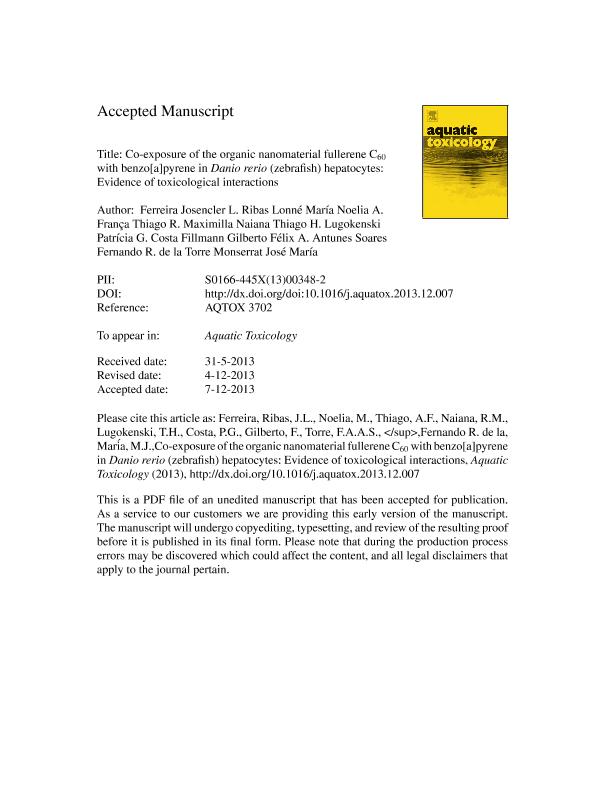Artículo
Co-exposure of the organic nanomaterial fullerene C60 with benzo[a]pyrene in Danio rerio (zebrafish) hepatocytes: Evidence of toxicological interactions
Ribas Ferreira, Josencler L.; Lonné, María Noelia ; França, Thiago A.; Maximilla, Naiana R.; Lugokenski, Thiago H.; Costa, Patrícia G.; Fillmann, Gilberto; Soares, Félix A.; de la Torre, Fernando Roman
; França, Thiago A.; Maximilla, Naiana R.; Lugokenski, Thiago H.; Costa, Patrícia G.; Fillmann, Gilberto; Soares, Félix A.; de la Torre, Fernando Roman ; Monserrat, José María
; Monserrat, José María
 ; França, Thiago A.; Maximilla, Naiana R.; Lugokenski, Thiago H.; Costa, Patrícia G.; Fillmann, Gilberto; Soares, Félix A.; de la Torre, Fernando Roman
; França, Thiago A.; Maximilla, Naiana R.; Lugokenski, Thiago H.; Costa, Patrícia G.; Fillmann, Gilberto; Soares, Félix A.; de la Torre, Fernando Roman ; Monserrat, José María
; Monserrat, José María
Fecha de publicación:
12/2013
Editorial:
Elsevier
Revista:
Aquatic Toxicology
ISSN:
0166-445X
Idioma:
Inglés
Tipo de recurso:
Artículo publicado
Clasificación temática:
Resumen
Compounds from the nanotechnology industry, such as carbon-based nanomaterials, are strong candidates to contaminate aquatic environments because their production and disposal have exponentially grown in a few years. Previous evidence shows that fullerene C60, a carbon nanomaterial, can facilitate the intake of metals or PAHs both in vivo and in vitro, potentially amplifying the deleterious effects of these toxicants in organisms. The present work aimed to investigate the effects of fullerene C60 in a Danio rerio (zebrafish) hepatocyte cell lineage exposed to benzo[a]pyrene (BaP) in terms of cell viability, oxidative stress parameters and BaP intracellular accumulation. Additionally, a computational docking was performed to investigate the interaction of the fullerene C60 molecule with the detoxificatory and antioxidant enzyme πGST. Fullerene C60 provoked a significant (p < 0.05) loss in cellular viability when co-exposed with BaP at 0.01, 0.1 and 1.0 μg/L, and induced an increase (p < 0.05) in BaP accumulation in the cells after 3 and 4 h of exposure. The levels of reactive oxygen species (ROS) in the cells exposed to BaP were diminished (p < 0.05) by the fullerene addition, and the increase of the GST activity observed in the BaP-only treated cells was reduced to the basal levels by co-exposure to fullerene. However, despite the potential of the fullerene molecule to inhibit π GST activity, demonstrated by the computational docking, the nanomaterial did not significantly (p > 0.05) alter the enzyme activity when added to GST purified extracts from the zebrafish hepatocyte cells. These results show that fullerene C60 can increase the intake of BaP into the cells, decreasing cell viability and impairing the detoxificatory response by phase II enzymes, such as GST, and this latter effect should be occurring at the transcriptional level.
Palabras clave:
Nanotoxicologia
,
Fulereno
,
Cultivo Celular
,
Glutationa-S-Transferase
Archivos asociados
Licencia
Identificadores
Colecciones
Articulos(SEDE CENTRAL)
Articulos de SEDE CENTRAL
Articulos de SEDE CENTRAL
Citación
Fillmann, Gilberto; Lonné, María Noelia; Maximilla, Naiana R.; França, Thiago A.; de la Torre, Fernando Roman; Monserrat, José María; et al.; Co-exposure of the organic nanomaterial fullerene C60 with benzo[a]pyrene in Danio rerio (zebrafish) hepatocytes: Evidence of toxicological interactions; Elsevier; Aquatic Toxicology; 147; 12-2013; 76-83
Compartir
Altmétricas



